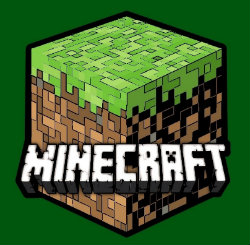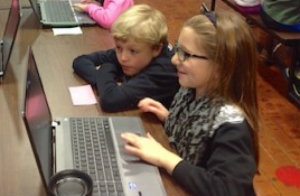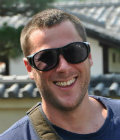Mixing Minecraft and California History

By David Goldberg
It was time. I had to give something new a try. Every spring for the last decade our fourth graders have been tasked with writing a comprehensive research paper about the California mission system. In their studies of the Spanish exploration and eventual settlement of California, the students had been playing “The Galleon Game,” an interactive simulation designed in 1980.
For many students, these activities were memorable, but I questioned whether or not they were teaching the 21st century skills that were needed in today’s world. The games were fact based and the paper was focused primarily on the details of the mission structure.
Engaging 21st century 4th graders
With each passing lesson, many of my students became more and more restless. The gathering of facts, while interesting at first, had lost its mystique.
The students seemed in need of more. I reflected each day, debating in my mind how I could create a unit that provided more space for students to use critical thinking skills, evaluate choices, and analyze perspectives of historical figures. In my heart I believed that changes needed to be made.

Melding Spanish exploration & Minecraft
I would start by studying the Spanish exploration to the new land. The students would analyze the motives of Columbus and Cortes, evaluate the factors that led to exploration, and then embark on their own 21st century expedition to my teacher-created Minecraft planets. The students would arrive on these planets, build a rover out of “stuff,” and eventually settle the land using Minecraft tools.
It felt like a genius plan; it was incorporating components of STEAM and was both innovative and inventive. The change was also a first step on the road to adjusting curriculum to reflect 21st century skills.
Each passing day, the chatter of Minecraft grew louder. Talks of spawns and obsidian dominated every free moment. I was growing anxious that I was about to enter a domain that was so far out there I couldn’t manage it. When late April finally rolled around, our experiment in technology began. We entered the media center and the pulse was palpable; the roars of excitement were deafening.
I knew I had something special in this unit. Students that were often disengaged, challenged by reading texts, and reluctant to think critically were ready for their mission. The student’s authentic expedition was set to begin!
Still from Minecraft-San Diego Mission Project by Peter de Tagyos – Source: KCET
Initial challenges
Unfortunately, the game did not go as planned. The same students who were reluctant to think also refused to build. The students that had a previous history with Minecraft were too consumed with the differences between “the school game” and “their game” that they could not transfer the historical concepts. Students would start to build their settlement, only to have another group of students build within feet of their camp. The classroom, as well as the creative world, was in chaos.
While I was no less committed to the idea of this change in the curriculum, I knew that I would need to iterate the process so that it could be more effective. It was during this reflective moment that I realized I could integrate an authentic learning moment into the game. I froze the game, and called a “democratic camp meeting” (a term my students were quite familiar with from our study of life in a mining camp) to discuss the issues at hand.
Enthusiastic play, questionable learning

With new rules in place, the race was on. I watched as students rushed to stake their claim. I watched as students experienced in a virtual world the intensity, excitement, and disappointment the forty-niners experienced during the California Gold Rush.
However, the students didn’t seem to make this connection as I would have hoped. This lack of connection became more evident as the game progressed. I watched as students fought over territory just like the Native Americans and the Spanish did. I watched as commanders (student leaders) met to discuss strategies about how to make their empire stronger and more powerful.
Alliances formed and enemies grew. Yet the connection to history was never made. Although the students were virtually experiencing historical life, they didn’t seem to see the parallels.
My search for answers
So, that brings me to where I sit today. Back at the drawing board, looking for answers. How can I use Minecraft to simulate the Spanish colonization of California and the building of the missions? How can we as educators help students experience history, virtually?
Might it be helpful to implement journal writing similar to the explorers of the past? Are games even necessary in supporting students’ connection to a historical era? It is these questions that linger as I think about the fall and how I can create thoughtful and meaningful lessons that teach my students 21st century skills while integrating valuable historical information.
If you have ideas for David, please share in the comments.





































I think you’re on to something with your journaling idea. Even if it’s not a journal per se, adding some sort of required role play shown through a combination of writing assignment, drawings, and/or performance art would require students to place themselves in the shoes of settlers and make those connections. It will also reinforce the lessons learned in their Minecraft settlements, and differentiate for various learning styles. Alternatively (or in addition depending on time), you could bring in grade-appropriate firsthand primary source documents or short stories during reading class, and make an assignment that connects to the Minecraft world. Example: Settlers and natives warred over territories. What has been your experience with conflict over territory? How did you overcome it?
Dannielle,
Thanks so much for your input. I appreciate your idea about having students reflect and think about their experience in a virtual world. I look forward to sharing about how the unit develops next fall.
David
Your thoughtful and honest reflection on this project is so refreshing. I really hope that you find a solution but in the meantime, hopefully other teachers (me included) will be encouraged to bring the rigor of your analysis to their own experiments with gaming.
Adrian,
Thanks for the feedback. I found reflecting on the unit quite helpful, as I prepare to make changed this fall. Please keep us posted about how gaming works in your classroom.
Best,
David
I have never taught California Missions, but I will tell you more or less what I would do. I would start at the end. What is it that you want them to learn? (what is the standard/s?)…. With that in mind, create a “path” that leads them to that new knowledge, scaffolding it for them… each “step” in the path would get them closer to reaching the goal… They should be accountable to prove each step they take with evidence that they gather as they read, research or play… I hope this helps or at least inspires you somehow because I think what you are doing is just awesome!
Hi Debbie,
I couldn’t agree more! Holding students accountable to the learning, as well as using backwards design to create a path is a great start. I look forward to sharing my findings as a revise the unit for the fall.
Best,
David
Maybe the students could be given a rubric with what’s expected in relation the the historical details and events. As they work, they would need to check off the details. I also think that Minecraft has a story telling ability. (I can get the details from my daughter if you want.) It may be necessary for the students to include a narrative connecting to the history.
Hi Deborah!
I so appreciate the narrative idea. Any features of Minecraft that you can share would be great.
Thanks,
David
Great reflections! Maybe some kind of screen casting so they need to share their connections to their knowledge of history? I’m from Australia, so not familiar with your unit, but kids always seem to try harder when they have to share. A 2-5 minute tour of what they’ve built and why to be presented to the class, maybe even call it a ‘Connection Log’ or something, so they really get the purpose?
Thank you for sharing your experiences,
Lucy
Hi Lucy,
Thanks for your ideas! Hopefully, we can implement a “tour” of the settlements this fall.
Best,
Davd
Minecraft is great, but quite honestly kids spend enough time in front of devices in their spare time, and I don’t think incorporating these types of games helps their critical thinking skills. I believe they need to spend more time talking to one another and brainstorming by sharing ideas in a collaborative way. Instead of writing a “comprehensive research paper”, which would likely be daunting for a 4th grader and probably pretty boring, perhaps have them work together to do a skit or write a play that they could perform for the class.
Hi Noel,
Thanks so much for your input. I appreciate your insight and suggestions. Working together to perform a skit sounds engaging and something my students would really connect with. Additionally, while I agree that using devices can become too much for some students, the collaboration of “teams” in Minecraft was inspiring. Students needed to discuss, analyze, and evaluate choices of where to build, what materials to use, how much land to claim, and eventually if they would form alliances with other “teams.” Each decision required great thought and cooperation as well as including many of the higher level thinking that we ask our students to do each day. Hopefully, next fall we will continue to thoughtfully build on integration of technology in the classroom.
Best,
David
Interesting idea…I understand by your examples of their learning via mine craft that they are applying the concepts that you intended for them to learn…was that not the point ? Then at that point, using their experiences and choices made in their game worlds, couldn’t you introduce the California Mission world ? The “project” then includes one of sharing by each expert ( they created the world…whether perfect or not) I’m more of a believer in teaching the concept, not the content…
I recommend MinecraftEDU.
David, I am intrigued by your ideas. I have long been trying to find better ways to not only engage students in history (I also teach fourth grade) but somehow make the mission system relevant to their time. I personally believe that the missions are overused in fourth grade with little benefit. I love the idea of using mine craft since I know students are competent with it. That is my problem. I have no idea how to use it. Perhaps you have given me a challenge to learn it in the next few weeks. There is something here. I hope you will continue to think it through and report what you come up with.
Hey David, I actually use Minecraft EDU in my classroom. One of our units, which could be similar to yours, was on Ancient Greece. I made a small replica with information blocks that the students had to go around and read. They answered questions from what they read while seeing a visual representation of the building for example. Afterwards, we studied some of the Ancient Greek forms of government and the class did a pros and cons. They selected the one they wanted and from there created their own Greek city-state by using research and listening to who was in charge. It actually worked out great and they enjoyed every second of it. And this was with 3rd graders!
A great blending of technology with history. Like Fran, this motivates me to continue learning the software. Although retired, I still keep up with current research in education. The concept of narrative (Deborah) is a great mental model for all study: Actor-Acts-Impacts-Consequences. Add the component of group interaction and you have the examination of purposes (Lucy), which should include the standard outcome (content and skill), including a variety of evidence through projects and reports. Purpose, by the way is not just the student learning purpose, but also the purpose of the social group being studied. Stay with it. It’s going to yield great benefits for teachers and students.
I did this several years ago in 7th grade Texas History as a PBL. I will email you what I did and see if it might work for you. At that time, I allowed students to use their own Minecraft and upload a video to YouTube,. This year, we have Minecraft.Edu so I’m not exactly sure how it will work out, but maybe you can get some ideas.
Hi Sherry,
Thanks! I look forward to hearing from you. You can email me at David.goldberg@heschel.com.
Best,
David
I believe this experience was beneficial for your students and I’m glad to see you haven’t abandoned the project this school year. I think a T chart comparing your students’ experiences to mission/gold rush history would help students see the parallels you observed. I am an 8th Grade History teacher and appreciate the motivating projects you are creating–you are getting young minds prepared to be life-long historians!